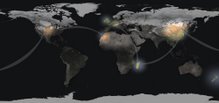
Glossary of Maori words (which commonly form part of place names): Motu = island. Rata is a red-flowered kind of myrtle. Moturata is a rocky fold marooned at the mouth of the Taieri River. Long spines of drowned land stretch south to hook hills to reefs ramped north under waves. Sand and tide make a shifting bridge to the last hill above water. Now it's there, now it isn't.
Six minutes from home, when the moon and wind are right, you can walk it. The sun went down, rain swung south, and the penguins came to roost. Their feet flapped. They came in clumps and teams from the roiling kelp to the tangle of bush. They can't see very well. At night, little blue flocks walk right past.

On the back side of the island, there's nothing but sea. Dunedin glows like a volcano behind the peninsula in the north. Moturata is full of strange whistles and trills. Dark waves. Clefts and caves and shadows of bushes overhead. The bridge is out of sight behind the hill. Nothing guarantees it will still be there when we come around the other side. It appears for three hours at a time, in a place where time seems strange and numbers stranger.
There is plenty to find and look at. Plenty to hear and imagine as we grope our way over hissing cracks and slippery weed. The lights of shore come into view again. The sea is climbing. The reflection of the sand is drowned, there is water between. We splash through, current tugging at the knees.
The island is a dark smudge in the sky behind us. We gain the van. The cops wonder where we've been. Or maybe they just wonder why.






